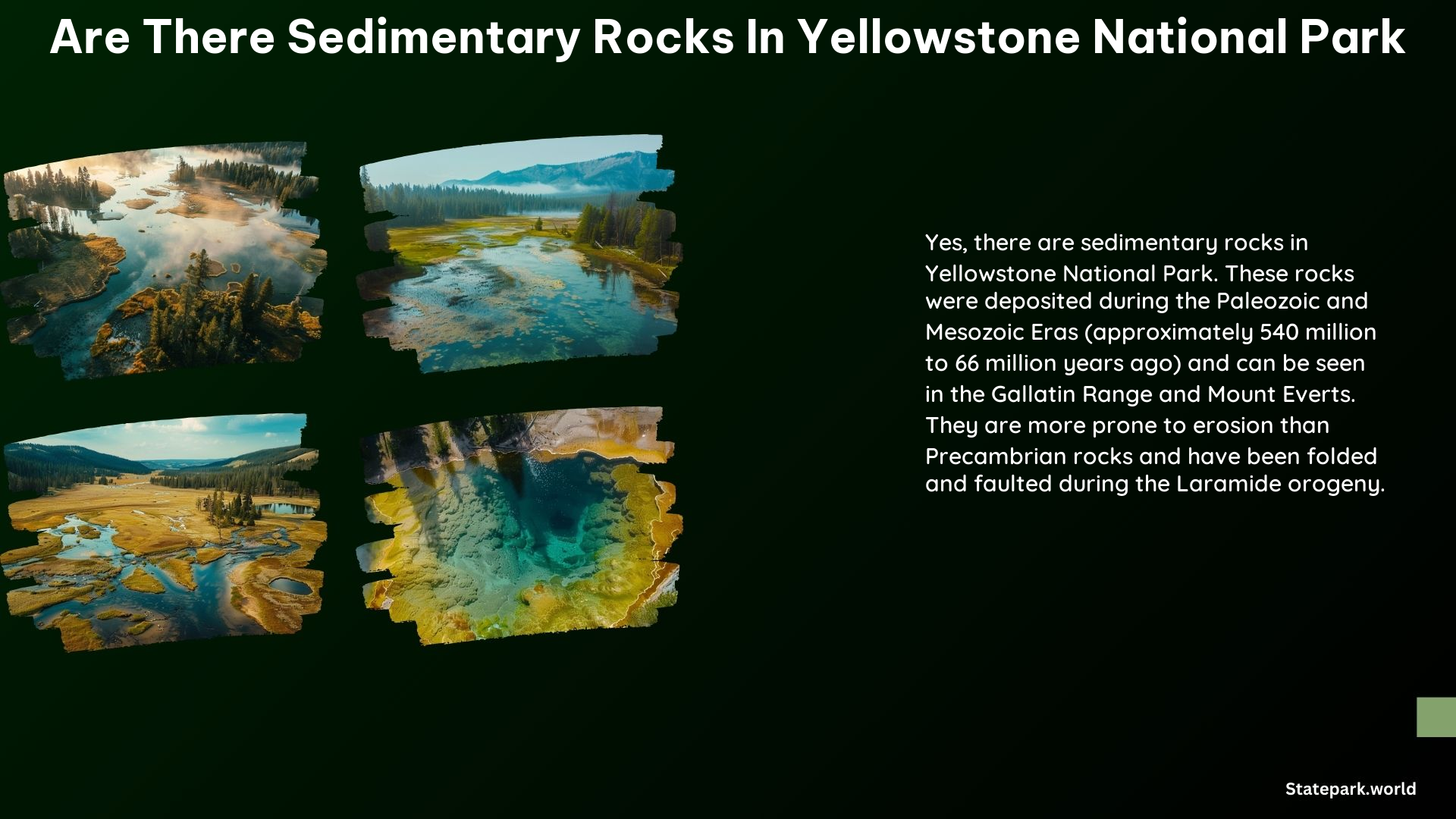Yes, there are sedimentary rocks in Yellowstone National Park. These rocks were deposited by seas during the Paleozoic and Mesozoic eras, approximately 540 million to 66 million years ago. They can be found in the Gallatin Range and Mount Everts, where they are overlain by volcanic deposits such as the Huckleberry Ridge Tuff.
Types of Sedimentary Rocks in Yellowstone National Park
The sedimentary rocks found in Yellowstone National Park include:
-
Limestone: Limestone is a sedimentary rock composed primarily of calcium carbonate (CaCO3). It is formed by the accumulation of the remains of marine organisms, such as shells and coral, over millions of years. Limestone can be found in the Gallatin Range and Mount Everts.
-
Sandstone: Sandstone is a sedimentary rock composed of sand-sized grains of mineral, rock, or organic material. It is formed by the compaction and cementation of sand grains over time. Sandstone can be found in the Gallatin Range and other areas of the park.
-
Shale: Shale is a fine-grained sedimentary rock composed of compacted clay or silt particles. It is formed by the deposition and compaction of mud or silt at the bottom of ancient seas or lakes. Shale can be found in the Gallatin Range and other areas of the park.
-
Conglomerate: Conglomerate is a sedimentary rock composed of rounded pebbles, cobbles, or boulders cemented together by a finer-grained matrix, such as sand or silt. It is formed by the deposition and cementation of coarse-grained sediments. Conglomerate can be found in the Gallatin Range and other areas of the park.
How Sedimentary Rocks Contribute to Yellowstone’s Landscape and History

The sedimentary rocks in Yellowstone National Park play a significant role in shaping the park’s landscape and contributing to its geological history.
Landscape Formation
The sedimentary rocks in Yellowstone, such as limestone, sandstone, and shale, were deposited in ancient seas and lakes during the Paleozoic and Mesozoic eras. Over time, these rocks were uplifted and exposed by tectonic forces and erosion, creating the rugged, mountainous terrain that characterizes much of the park.
The Gallatin Range, for example, is composed primarily of sedimentary rocks that were uplifted and folded during the Laramide Orogeny, a mountain-building event that occurred approximately 70 to 50 million years ago. The erosion of these sedimentary rocks has resulted in the formation of steep cliffs, canyons, and other distinctive geological features.
Geothermal Activity
The sedimentary rocks in Yellowstone also play a role in the park’s geothermal activity. The porous and permeable nature of some sedimentary rocks, such as sandstone, allows for the movement of geothermal fluids and the formation of hot springs, geysers, and other thermal features.
Additionally, the impermeable nature of some sedimentary rocks, such as shale, can act as a barrier to the upward movement of geothermal fluids, contributing to the development of the park’s unique hydrothermal systems.
Paleontological Significance
The sedimentary rocks in Yellowstone National Park also contain important paleontological evidence of the park’s ancient past. Fossils of marine organisms, such as trilobites, brachiopods, and crinoids, have been found in the limestone and shale deposits, providing valuable information about the park’s prehistoric ecosystems and the evolution of life on Earth.
These fossils offer insights into the environmental conditions and the types of organisms that inhabited the region millions of years ago, contributing to our understanding of the park’s geological and biological history.
Preservation and Conservation of Sedimentary Rocks in Yellowstone
Yellowstone National Park is a protected area, and the preservation and conservation of its geological resources, including the sedimentary rocks, are of paramount importance. The National Park Service works to ensure that these valuable resources are protected from human-caused damage and disturbance.
Visitors to the park are encouraged to observe and appreciate the sedimentary rocks, but are prohibited from collecting or removing them. This helps to maintain the integrity of the park’s geological features and ensures that they can be enjoyed by future generations.
In addition, the National Park Service conducts ongoing research and monitoring of the park’s sedimentary rocks, studying their composition, formation, and role in the overall ecosystem. This information is used to inform management decisions and to educate the public about the importance of these geological resources.
Conclusion
The sedimentary rocks in Yellowstone National Park are a testament to the park’s ancient geological history and play a crucial role in shaping its unique landscape and ecosystems. From the limestone and sandstone of the Gallatin Range to the shale and conglomerate found in other areas of the park, these rocks offer a window into the past and contribute to the park’s rich geological and paleontological heritage.
By understanding and appreciating the sedimentary rocks in Yellowstone, visitors can gain a deeper appreciation for the park’s natural wonders and the processes that have shaped it over millions of years. Through responsible stewardship and conservation efforts, these valuable resources can be preserved for generations to come.
Reference:
– Geology of Yellowstone National Park
– Sedimentary Rocks in Yellowstone National Park
– Paleontology in Yellowstone National Park
